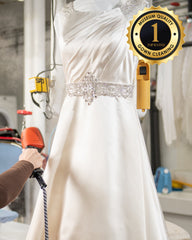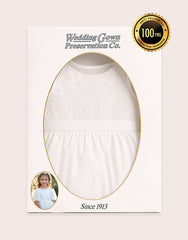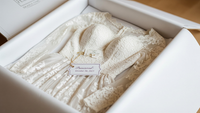Every bride dreams of her wedding day, and her wedding dress plays a huge role in making the day special. After the wedding, many brides want to preserve the clothing to reflect and remember the day for years. But keeping a wedding gown is a challenging task. From protecting the material from staining and fading to ensuring it doesn’t yellow over time, it’s a delicate process. Luckily, we’re here to help. This guide will provide tips and tricks to keep your gown in perfect condition for years. From the best ways to store the dress to how to clean and repair any damage, you’ll be able to keep your clothing looking beautiful for many years to come.
What is wedding gown preservation?
Wedding gown preservation is treating your gown to reduce fading, yellowing, and damage from moths. Wedding gown preservation is recommended for wedding gowns of high sentimental value and cost a significant amount of money. Preservation is not necessary for every wedding gown; it’s recommended for dresses that are significant in weight and that you wish to keep for a long time. Preservation of wedding gowns is not a new concept. Wedding gowns go back as far as ancient Egypt. Wedding gown preservation is simply a modernized way of keeping your wedding gown in pristine condition for years to come.

Preparing the dress for preservation
Before you can preserve your wedding gown, cleaning, repairing, and removing any items sewn into the shift is crucial:
- You’ll want to remove any buttons, embroidery, or jewelry sewn into the dress. These items will often fall out over time and can cause damage to the rest of the dress. Removing them is best, so they don’t fall out and get lost.
- You’ll want to repair any tears or stains on the gown. You’ll also want to iron the dress to remove wrinkles and creases from being boxed up for so long.
- You’ll need to remove all the tulle from the dress.
Wedding gowns often include tulle along the hemline and around the train for decoration. This tulle is usually removed from the shift during cleaning, but you still want to remove it, so it doesn’t damage your dress over time.
Storing your dress for long-term preservation
The best way to store your wedding gown for long-term preservation is in a clean, dry, and climate-controlled environment. A clean environment is crucial because it prevents dust, dirt, and other particles from damaging your dress. A dry environment is also essential to prevent mold or mildew from forming on the gown. A climate-controlled environment is critical because too much heat or cold can damage your gown over time. You can store your dress in a garment bag on a shelf or in a box to keep it clean and protected from dust. It’s best to avoid storing your gown in plastic bags as they can trap moisture and cause damage over time. You’ll also want to keep your dress in the dark place to prevent it from fading over time.

Cleaning a preserved wedding gown
When cleaning a preserved wedding gown, it’s essential to use a gentle cleaning solution. You can use a mild detergent or a unique wedding dress cleaning solution to clean the gown. Avoid harsh chemicals, bleach, or fabric softeners, as they can damage the dress over time. It’s also essential to never use a washing machine to clean your wedding gown. Doing so can cause damage to the shift and is not recommended. To clean your dress, place it in a clean sink or bucket with clean water, and add the cleaning solution. Swirl the gown around in the water and solution to remove any dirt or stains. Make sure to clean the bottom of the dress to remove any dirt or particles that may have gotten trapped in the hemline. Once clean, gently rinse the gown and hang it up to dry.

Repairing damage to a preserved wedding gown
If your preserved wedding gown is damaged, you can contact a professional to repair it. Many preservationists offer repairs as part of their wedding dress preservation services. A preservationist will likely repair the damage by removing the damaged fabric and replacing it with new material. Cleaning a preserved wedding gown is best left to a professional. If you attempt cleaning your gown yourself, you risk damaging or destroying the dress. Repairs, on the other hand, can be done at home if you have the proper skills. If you’re not experienced in sewing, it’s recommended that you leave repairs to the professionals. If a button has come loose or a tear has formed in your dress, you can quickly fix these problems at home.
Common problems with preserved wedding gowns
There are a few common problems associated with preserved wedding gowns. First, wedding gown preservation often leads to the yellowing of the dress. That is caused by the chemicals used in conservation and can be reversed with unique cleaning solutions. Second, preserved gowns often lose their shape over time due to the weight of the fabric. Wedding dress preservation experts can help restore the gown’s shape. Finally, preserved wedding gowns often have a musty odor. That is caused by trapped moisture and can be easily removed with a thorough cleaning.
Tips for finding a reputable preservationist
Selecting a local preservationist for your area is also a good idea. You can visit the preservation studio if you have any questions or concerns. Consider cost when choosing a preservationist. Some preservationists charge per gown, while others charge by the pound. Pick the one that best meets your needs and budget. An organization ensures that preservationists are appropriately trained and qualified to do the job. When choosing a preservationist, make sure they have experience preserving wedding gowns.

Alternatives to preservation
People often wonder if there are other ways to preserve a wedding gown. While wedding gown preservation is the best way to protect the dress, you can also store your gown in a garment bag. You can find garment bags online that are specially designed for wedding gowns. Make sure to keep your dress clean and dry, away from heat, sunlight, and pollution. You can also store your gown in a box or on a shelf with a garment bag on top. Again, ensure the area is clean and away from sunlight to prevent fading and damage. You can also frame your gown and hang it on the wall. You can find specially designed frames to fit most wedding gowns. That is a great way to display your dress and protect it simultaneously. Finally, you can keep your gown in a box in a closet or on a shelf. This way, you can always look back at your dress when you want to remember the special day.
Conclusion
Wedding gowns are special garments that deserve to be preserved and protected. Wedding gown preservation is the best way to keep your gown looking new and clean for years to come. Although it can be costly, the benefits are well worth it. Wedding gown preservation is recommended for gowns of high sentimental value and cost significant money. The best way to preserve a wedding gown is to clean, repair any damage, and store it in a clean, dry, and climate-controlled environment. When it comes to wedding gown preservation, it’s best to be prepared.












 200 Business Park, Freehold, NJ 07728
200 Business Park, Freehold, NJ 07728
 (866) 308-8822
(866) 308-8822 info@trustedweddinggownpreservation.com
info@trustedweddinggownpreservation.com
